Update on Peatbog Habitat Re-creation on the Marches Mosses
July 24, 2020
Work restarted in early July on the project to create a layer of turf to cover sections of the former scrapyard site on Whixall Moss, while re-creating peatbog habitat on a nearby peaty field. Led by Natural England as part of the BogLIFE project to restore the Marches Mosses, work began again after a long delay due to high rainfall last winter and the COVID-19 lockdown this spring. The work is being carried out by Shropshire contractor Steve Cornish of Redwood Tree Specialists and uses specialist machinery, including a 15 tonne excavator.
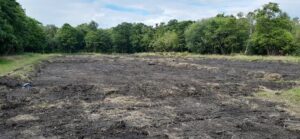
Turf stripping on peaty field near Whixall Moss – July 2020
The work involves removing the top turf layer from fields near the former scrapyard, which is part of Whixall Moss. The material that is removed is then used to cover the surface of the polluted ground of the scrapyard. Sheeting has been laid to act as a marker layer between the rocky scrapyard surface. This will be levelled off to an average of 50-100cm depth and left to re-naturalise over time. Within a year the areas should be covered in grasses and sedges and is expected to gradually develop into a wet woodland.
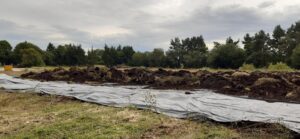
Removed turf awaiting levelling – July 2020
Steve Cornish adds some detail to the story: “We’re using a robot-guided laser leveller attached to the excavator. It’s an exciting experiment that we’re using here for the first time. We anticipate it will help us to work more efficiently, as we won’t need to stop to measure the depth of the turf as we level it. If it works as we think it will, we’ll be able to use this on other projects on the Marches Mosses and elsewhere.”
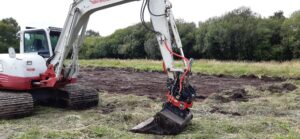
Lagg field behind old scrapyard – July 2020
The field, which sits on six feet of jelly-like peat, is part of the original bog complex. It was under-drained in the 1970s and used for grazing. Now that Steve’s team have finished preparatory work to expose the underlying peat, this low-lying area has been crossed with peat bunds. These will help contain rainwater and manage water levels in the bunded sections. This is needed to provide favourable growing conditions for bog plants.
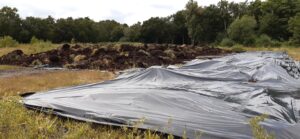
Turf removed from field near Whixall Moss – July 2020
The whole field will be sown with Sphagnum moss species that have been grown by BeadaMoss Micropropagation Services. The project team anticipate adding the Sphagnum moss in the early autumn, depending on weather conditions. In total, the aim is to restore eight acres of boggy habitat – around the size of four football fields. The restored bog habitat, which has a very important function in storing carbon, will help support the already restored central area of Whixall Moss.
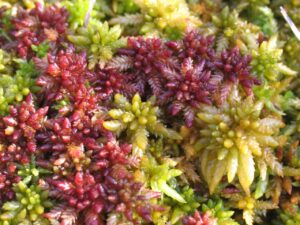
Sphagnum magellanicum and S. papillosum Credit: Colin Hayes
You can read the October 2019 News post that announced this work here.
A Brief Background of the Mosses
The Marches Mosses – Fenn’s, Whixall, Bettisfield and Wem Mosses – make up the third largest lowland raised bog in Britain, a Site of Special Scientific Interest and a European Special Area of Conservation. This peatland was formed over 12,000 years ago when Sphagnum moss began to grow in the wetland formed by the retreat of glaciers. The Sphagnum acidified the water, stopping the decay of plant remains. These built up like a sponge to form the raised expanse of the peatmoss, with the pickled water creating an environment suitable for the unique combination of plants and animals that thrive here.
Peatlands depend on retaining rainwater for their existence. The Marches Mosses began to collapse when the bog was drained over several hundred years, the dried peat was cut for fuel and agricultural and horticultural use, and the edge habitat around the Moss was turned into farmland. The decay of the peat meant that carbon that had been stored for millennia was being lost and by the late 1980s the Mosses were badly damaged.
In 1990 the peatland was acquired as a National Nature Reserve and restoration was begun. This has led to an increase in biodiversity as plants and animals that thrive in the boggy conditions return and repair of the peat has meant an increase in the store of carbon. Because peat stores more carbon than plants, trees and other types of soil, the Mosses are an important weapon in the fight against climate change.






